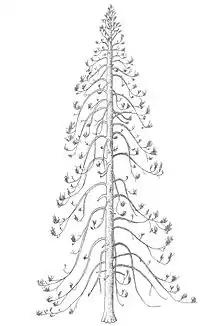Sorthat Formation
The Sorthat Formation is a geologic formation on the island of Bornholm, Denmark and in the Rønne Graben in the Baltic Sea. It is of Latest Pliensbachian to Late Toarcian age. Plant fossils have been recovered from the formation, along with several traces of invertebrate animals. The Sorthat Formation is overlain by fluvial to lacustrine gravels, along with sands, clay and in some places coal beds that are part of the Aalenian-Bathonian Bagå Formation.[2] Until 2003, the Sorthat Formation was included as the lowermost part of the Bagå Formation, recovering the latest Pliensbachian to lower Aalenian boundary.[3][4] The Sorthat strata reflect a mostly marginally deltaic to marine unit. Large streams fluctuated to the east, where a large river system was established at the start of the Toarcian.[2] In the northwest, local volcanism that started in the lower Pliensbachian extended along the North Sea, mostly from southern Sweden.[5] At this time, the Central Skåne Volcanic Province and the Egersund Basin expelled most of their material, with influences on the local tectonics.[5] The Egersund Basin has abundant fresh porphyritic nephelinite lavas and dykes of lower Jurassic age, with a composition nearly identical to those found in the clay pits. That indicates the transport of strata from the continental margin by large fluvial channels of the Sorthat and the connected Röddinge Formation that ended in the sea deposits of the Ciechocinek Formation green series.[5]
| Sorthat Formation | |
|---|---|
| Stratigraphic range: Latest Pliensbachian to Latest Toarcian ~Possible Lower Aalenian layers | |
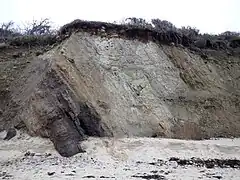 Korsodde section of the Sorthat Formation, where the local Toarcian anoxic event stratum is located | |
| Type | Geological formation |
| Unit of | Bornholm Group |
| Sub-units | Sorthat & Levka beds |
| Underlies | Bagå Formation |
| Overlies | Rønne & Hasle Formations |
| Thickness | 240 m (790 ft)[1] |
| Lithology | |
| Primary | Claystone, sandstone[1] |
| Location | |
| Coordinates | 55.09°N 14.42°E |
| Approximate paleocoordinates | Approx. 35°N |
| Region |
|
| Country | |
| Type section | |
| Named for | Sorthat-Muleby, Bornholm |
| Named by | Gry (as part of the Bagå Formation) [2] |
| Year defined | 1969 |
 Sorthat Formation (Denmark) | |
Stratigraphy

On Bornholm, the lower-middle Jurassic succession is composed of the Rønne (Hettangian–Sinemurian), Hasle (lower–upper Pliensbachian), Sorthat and Bagå Formations. The major Pliensbachian–Bathonian coal-bearing clays and sands that overlie the Lower Pliensbachian Hasle Formation are distributed between both the Sorthat Formation and the overlaying Bagå Formation.[1] The Sorthat Formation is the sister unit of the Röddinge Formation, with both being part of the same fluvial system, as well the regional equivalent of the Ciechocinek Formation of Baltic Germany and Poland, the Fjerritslev Formation of the Danish Basin and the Rya Formation on Scania.[1] The Sorthat Formation beds were referred originally to the Levka, Sorthat and Bagå beds.[2] A major section of the formation is the Korsodde coastal section, located on the southwest part of the island.[2] A detailed stratigraphic interpretation of the beds has been difficult to achieve, in part due to the complicated block faulting, but especially due to the absence of marine fossils and distinct marker beds.[2] The rocks were originally dated as Middle Jurassic using megaspore contents, with the Levka and Sorthat beds being roughly contemporaneous and the Bagå beds possibly slightly younger. Later, when more advanced palynological studies from locations such as the Levka-1 core-well and the Korsodde section Upper Pliensbachian stratum became available,[6][7] the coals and clays of the Levka beds were removed from the Bagå Formation, as were the coal-dominated beds of the Korsodde and Onsbæk sections.[3] At the time, several megaspores were found to be common in both the Bagå Formation and Sorthat beds, implying the presence of Toarcian–Aalenian strata,[3] although the dating of the megaspore-bearing strata is tentative.[8] With both, the palynological and sedimentological study of all available exposures and cores from the Lower–Middle Jurassic shows that the Hasle Formation (Lower–Middle Pliensbachian) is covered by a succession referable to both the Levka and Sorthat beds, which are composed mostly by bioturbated sands, heteroliths and clays along with abundant coal veins, and contain relatively diverse brackish to marine dinoflagellate assemblages that are indicative of upper Pliensbachian, Toarcian and possibly lower Aalenian strata.[6] The upper stratum is covered by the fluvial gravels and sands, along with lacustrine clays, carbonaceous clays and coals belonging to the Bagå Formation.[1]
Lithology

The Sorthat Formation has a highly variable lithology.[1] The main core studied from the rocks, the Levka-1 well, reveal first sharp-based units fining upwards, 3–14 m thick, consisting of coarse-grained, occasionally pebbly sand, overlain by muddy, coal- and mica-containing, fine- to medium-grained sand that is laminated to homogeneous clay and coal seams with roots.[1] On most of the strata there is a common parallel lamination with subordinate cross-bedding, cross-lamination and Flaser lamination.[1] There are abundant large plant fragments and small bits of quartz. Marine palynomorphs are absent, suggesting that this level was deposited on a coastal or delta plain with fluvial channels, lakes and swamps.[6] This is consistent with finds in the German portion of the Ciechocinek Formation, where a large deltaic system ended: the large Toarcian–Bajocian deltaic systems were the local shoreline, influenced by the proximity between brackish to freshwater and continental biofacies.[9][10] The North German Basin shows that on approximately 14.4 m.a, four third-order sea-level fluctuations led the subsequent formation of four individual delta generations in the Bifrons–Thouarsense (Toarcian), Murchisonae–Bradfordensis (Aalenian) and Humpresianum–Garatiana (Bajocian).[9] The Toarcian section was dominated by regressive elongated river-dominated deltas were due to the fall of the sea level the south to southwest directed delta progradation between the Lower and Upper Toarcian, that was deposited as 40 m of deltaic successions, found in places like Prignitz (east) and Brandenburg (north).[9] Most of the palynomorphs found in the Toarcian stratum are connected with ones found in the Sorthat Formation.[9]
Nearly 40 m thick, the upper section of the formation is composed mostly by a series of cross-bedded, cross-laminated, wave-rippled and bioturbated sand and heteroliths with sporadic syneresis cracks, pyrite nodules, the ichnofossils Planolites isp. and Teichichnus isp. and brackish to marine palynomorphs, mostly dinoflagellates.[1] This upper part has a stratum more characteristic of nearshore environments with abundant lagoons, coastal lakes and fluvial channels, with the clean sand at the top probably representing a marine shoreface.[1] The Korsodde section, 93 m thick, is composed mostly of coarse-grained sands with cross-bedding and parallel lamination, being mostly black due to an abundant organic debris.[1] This section has been interpreted as part of the large local fluvial system, probably as a series of minor fluvial channels that were connected with coastal lakes and lagoons where riparian vegetation was abundant, judging by the presence of megaflora remains and palynomorphs.[1] Small ichnofossil burrows and larger burrows, including Diplocraterion isp., are common, indicating that there was at least one subunit that was the fill of an estuarine channel.[1] The uppermost part of the formation in the Korsodde section consists of fine-grained sands of yellowish to brown color with cross-stratification and parallel lamination, along with sandstones with thin bioturbated and wave-rippled heterolithic beds.[1]
Profile
At Korsodde, the environment includes the following:
| Unit | Lithology | Thickness (metres) | Type of environment | Fossil flora | Fossil fauna |
|---|---|---|---|---|---|
|
Unit A |
Yellow, weakly cemented muscovite quartz sandstone, medium- to fine-grained in the lower part, fine-grained in the upper part. Ripple or herringbone lamination is present in most of the beds, along discontinuous mudstone drapes around 0.5 cm thick and mudstone intraclasts. The mudstones show often ferruginization. A single thin horizon occurs at about 85 cm of the section and also a thin erosional surface with mudstones at 1 m. There is a layer of heterolithic deposits with fine-grained ripple mudstones and sandstones at 1.65–1.75 m. |
0.45–2.3 m |
Estuarine channel fill (upper or marginal, less energetic part) |
None recovered |
|
|
Unit B |
Intercalations of muscovite quartz sandstones and dark mudstone drapes, with abundant heteroliths. In the vertical section, the sandstone layers (3 cm thick) are lenticular, with some displaying ripple cross- and herringbone lamination, and the mudstone drapes (0.5 cm thick) have wavy lamination. These last have a few laminae separated by thicker, coarser, mainly silty laminae showing abundant ferruginous cementation. There is a layer over B considered transitional to C. |
2.3–3.41 m |
Upper tidal flat deposits surrounding an estuary |
None recovered |
|
|
Unit C |
Two main layers: a series of 20 cm dark mudstone with horizontal lamination and silt intercalations and a series of dark heteroliths with intercalated mudstones and ripple limestones. |
3.41–3.7 m |
Restricted bay passing into upper tidal flat deposits |
None recovered |
|
|
Unit D |
Yellow ripple cross sandstone with abundant muscovite, alternating with continuous and discontinuous dark mudstone with abundant organic material. There are pyrite concretions in the lower part. |
3.7–4.7 m |
Lower tidal flat within an estuary |
Roots |
|
|
Unit E |
Mostly fine-grained sediments with abundant organic matter. Starts with 55 cm of muddy sandstone, dark at the beginning and light in the upper part. A bed of 5 cm of mudstone overlays the sandstone, followed by various levels of fine-grained sandstones interbedded with dark siltstone–mudstone, pyrite concretions and sandy mudstone. Over this is developed a massive coal layer containing Neocalamites stems where pyrite becomes more common. It is overlaid by mudstone and fine sandstone that turn into a poorly sorted yellow ferruginous layer. The upper part, 85 cm thick, is composed of mudstone with allochthonous Neocalamites stems and lignite clasts. |
4.7–6.9 m |
Lagoonal environment above a coal bed |
|
|
|
Unit F |
Mostly pale, fine-grained, ripple cross muddy sandstone and normal sandstone, separated by thin, pale sandy mudstones or thin mudstone drapes. Pyrite concretions and lignite clasts occur in the sandstones. There are synaeresis cracks noted at 8.15–8.75 m. |
6.9–9.9 m |
Tidal flat deposits in an estuary |
|
|
|
Unit G |
A prominent erosional surface at the start, composed of yellow medium- to fine-grained cross-laminated sandstones with muscovite. |
9.9–11.35 m |
Estuarine bar |
None reported |
None reported |
|
Unit H |
Pale, fine-grained ripple and herringbone sandstones and mudstones, with intercalations of sandy mudstones and mudstone drapes with intense ferruginization, and some layers of mudstone–sandstone heteroliths |
11.35–14.2 m |
Marginal part of an estuary channel fill |
None reported |
|
|
Unit I, J |
Bioturbated muddy sandstone |
14.2–14.4 m |
Short-lived bay or lagoon |
|
|
Palynostratigraphy
The Sorthat Formation represents one of the most complete floras found in Europe dating to the Pliensbachian–Toarcian boundary, as well as among Jurassic palynological deposits found worldwide.[4][7][8][12]
Environment

Beyond the deposits on the west and south coast of Bornholm, the formation is present in the Stina-1 well, which belongs to the Rønne Graben (a large offshore pull-apart basin that also includes the westernmost fringe of the island of Bornholm), where both the Sorthat and the Bagå Formation are deposited on the hanging wall fault block close to the main eastern bounding fault of this graben along the west coast of the island.[13] This graben was in part emerged during the deposition of the Sorthat Formation, as proven by the sand and clay with numerous coal horizons from the Stina-1 well.[14] The presence of a high kaolinite content in both coeval marine Danish Basin and local Bornholm, as well the abundant reworked Carboniferous palynomorphs, indicate significant erosion of a Carboniferous regolith, which was almost completely eroded by the Middle Jurassic. This suggests Pliensbachian–Toarcian rivers eroded the Bornholm High, eliminating all of the Carboniferous layers and leaving only older Palaeozoic strata, as proven by the granite of the younger Bagå Formation.[15] Due to a Late Pliensbachian marine regression, deposition of coal-bearing strata in the Sorthat Formation resumed on Bornholm until an Early Toarcian transgression terminated peat formation.[16] The two main deposits of the formation, seen at the Levka-1 well and the lower part of the Korsodde section, were deposited in an environment influenced by the sea, the Levka location being populated by lagoons, lakes, channels and low fluvial areas.[16] Then deposition of the Sorthat Formation in the Latest Pliensbachian–Toarcian demonstrated a rapid subsidence and relative sea level rise of the Rønne Graben, while the adjoining Arnager Block suffered a relative sea level fall. This is because the Rønne Graben experienced a rapid relative sea level rise during the Early Toarcian, coeval with the prominent rise registered in the Danish Basin.[13] This peak transgression of the Ligurian Cycle is found in the coeval layers of the Fjerritslev Formation. The Bifrons to Levesquei zone in the coeval units at the east and west of Prignitz, a sandy coastal-deltaic succession, was replaced by laminated shales with pelagic marine fauna, reflected in the shoreline shifts to the northeast, which contributed to retrogradational stratal pattern architectures.[17] In the Sorthat Formation, a transition occurs from upper to lower shoreface environments, indicating a deepening trend. In the Younger Levesquei subzone, delta plain environments were replaced by shoreface setting with active bioturbation and hummocky cross-stratification.[17] The Rǿnne Graben shows seismic lines with onlapping patterns that have been correlated to these Lower Toarcian marine shoreface deposits with intense bioturbation.[13]
The depositional environments include the following:
- The Levka beds start overlying the foreshore deposits of the Hasle Formation.[18] They are composed mostly of interbedded sand, clay and coal beds. Loose sand constitutes the main parts of the unrecovered intervals.[19] This sand is fine to medium-grained, micaceous, very carbonaceous and muddy, showing mostly parallel lamination, with rare cross-bedding, cross-lamination and flaser lamination.[19] These first levels are interpreted as fluvial channel fills, reflecting active channel deposition followed by decreasing current strength and channel abandonment with a passive phase of clay deposition, final overgrowth and change into peat-forming swamps.[19] Between the channel fills are intervals with thinly interbedded sand and clay and common occurrence of rootlets, coal seams and rapid facies changes, interpreted as representing wet, vegetated, floodplain with shallow lakes, swamps and small crevasse deltas receiving overbank spills from nearby active channels.[19] Coal seam analyses revealed that the peat-forming swamps were water-saturated, densely vegetated, anoxic and nutrient-rich.[19] It was followed by a coastal or lower delta plain environment, populated by abundant large fluvial channels or distributaries, and nearby floodplain areas where lacustrine–lagoonal mud, crevasse splays and peat accumulated.[19] Later a rise in the sea level is signalled by the increase of acritarchs and Tasmanites, where a lagoon succession is overlain by the fill of a coastal lake that developed into a palaeosol.[19] Later, marine palynomorphs became absent and the location became again a crevasse delta and fill of an abandoned fluvial channel, intercalated with lake deposits.[18] After this, a lagoon succession is marked with the appearance of Planolites and Teichichnus burrows and dinoflagellate cysts of Nannoceratopsis gracilis, N. senex and N. triceras and common occurrence of Botryococcus, indicating a major marine rise event.[18]
- The Sorthat beds consist of a series of intercalated minor or major extended lower delta plain environment deposits, with pyrite nodules and the trace fossil Arenicolites.[18]
- The Korsodde section overlies the fine-grained sandstones of the Hasle Formation, deposited on a high-energy shoreface environment.[19] This section of the formation started as a derivative of sand units deposited in fluvial channels, with abundant carbonaceous matter probably derived from extensive erosion of peat accumulations during changes in channel courses, as indicated by the abundant presence of rootlets and coaly beds.[19] The intrusion of younger clay beds led to a gradual infilling of relatively small coastal lakes and enclosed lagoons, which became vegetated and turned into peat-accumulating environments (isolated from active clastic sedimentation), eventually forming palaeosols. This units are filled with pyrite nodules and medium-large wood fragments, while the genera Botryococcus, Lecaniella and Mendicodinium (represented by M. reticulatum) occur in varying amounts ranging from abundant to rare, with a few acritarchs also present.[18] This stratum is overlaid by the intercalation of crevasse delta deposits and lacustrine–brackish flooding surfaces with shifts between ordinate and subordinate tidal currents, with scattered small burrows (Diplocraterion) and mud drapes on foresets containing abundant Nannoceratopsis senex.[18] Mancodinium semitabulatum and Mendicodinium groenlandicum are also found in this sections, but subordinated to the inner fluvial dominated part of an estuarine channel, overlaid by a tidally dominated part.[18] Lagoons in various conditions on younger deposits suggest sea level rise, intercalated with riverine deposits, on a series of regression–transgression trends.[18]
- In the Rønne and Kolobrzeg grabens along the Arnager Block representative offshore layers of the formation appear in the Baltic Sea.[20] In the Rønne Graben this unit is found in a landward direction towards the Arnager Block. The absence of the Sorthat Formation in the Pernille-1 borehole of the Arnager Block could be due to an inversion of the strata, although emersion of this block cannot be ruled out. The whole system is thought to have built a southeast to southwest erosion due to the seaward orientation of the Arnager Block, which tilted towards the northwest. Lagoonal to deltaic systems developed locally, fed by the currents coming from either the Skarup Platform to the west, the Bornholm High to the north and likely the Arnager Block.[20]
Inertinite has been recovered from the coal-bearing levels of the formation, where the palynology shows that the mire vegetation may have been dominated by gymnosperms and also contained ferns characterised by the genera Dicksonia or Coniopteris and the family Osmundaceae.[16] Biomolecules were found in several coal seams there, among which Euulminite and Attrinite were the most abundant huminite macerals recovered.[21] The Levka-1 well section represents fluvial channels, floodplain areas with shallow lakes and lagoons, and small crevasse deltas, with abundant coalified wood fragments and stems, most of them found associated with sandy channel fills and on heavily rooted crevasse and lake deposits in shallow inter-fluvial areas.[16] In the Toarcian at Bornholm, strata indicate a warm, humid climate suggested by the large number of plant species from the interconnected Jameson Land, and thin cutinised leaves of Podozamites and Equisetales comparable in size to modern subtropical bamboos are thought to reflect favourable conditions for plant growth.[16] There is abundant coal, which indicates that wildfires occurred in the bog.[16] Wood particles from this section, both charcoalified and unburned (coalified), with many particles being rounded and worn, imply the influence of greater transportation energies.[22]
Coal
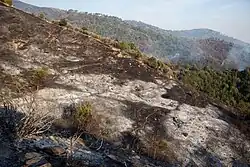
On Korsodde, the Lower Toarcian section records higher temperatures and decreased rainfall and humidity, which led to an increase of the potential for local wildfires, reflected in the increased abundance of charcoal and burnt plants.[23] In the section at Korsodde that includes the Toarcian oceanic anoxic event, thermophilic plant taxa imply that the climate was relatively dry, and presence of micro- and macroscopic charcoal indicates a spike of abundance and increase of the wildfire activity.[24]
Most of the coal seams recovered from the formation come from Levka 1 and the Korsodde section, and are derived in most cases from a densely vegetated, anoxic swamp, which was probably rheotrophic and rich in nutrients.[25] Study of the peat accumulation indicates that it occurred in rather short time intervals (around 2,300 years) and in a warm temperate to subtropical climate, falling short of the rate seen in tropical accumulations, such as the 1.8 mm/yr on the Batang Hari River in Sumatra.[25] Peat accumulation of 1 mm/yr is equal to that of modern Central Kalimantan coastal settings.[26] The deposits have great amounts of thin and clean coal seams, covered by lacustrine–lagoonal flooding peaks, indicating rapid changes in the environment that were controlled by fairly rapid subsidence of the Rønne Graben, which along with eustatic rise in sea level caused decreases and increases in the base level at the coastal plain.[25] The majority of the samples were immature, low-rank coals with generally very high content of humified organic matter, which indicates prevailing anoxic and fully saturated conditions during peat formation, with occasional inundations by freshwater that favoured humification of the plant tissues and also may have increased the gelification processes, raising the pH.[25] Hopanoids are abundant and an indicator of common bacterial activity.[25] The vegetation — both the nearby plants and those of the peat swamp — was probably small in stature, and its diversity suggests a humid, warm-temperate to subtropical climate that favoured prolific vegetation.[25]
- The Levka-1 well has a core of approx. 150 m through the Sorthat Formation, covering the underlying marine strata of the Hasle Formation.[25] The lower part includes 112 m of coal along with sand and clay. There is abundant large, coalified wood fragments and stems.[25] The coal-bearing strata of the Levka-1 are interpreted as fluvial channel fills, with active channel deposition followed by abandonment and a passive phase of clay deposition, gradual overgrowth and change into a peat-forming environment.[25] clay and coal seams present in this stratum have abundant rootlets and a non-marine palynomorph assemblage dominated by spores and pollen, interpreted as representing flood plain areas with shallow lakes, small crevasse deltas and swamps. Some sections have wave ripples, wavy and flaser bedding, bioturbation and transported Equisetites stems that are interpreted as the sediment fill of a local lagoon, deposited on a transgressive shoreline with a series of lagoon successions.[25] Levka-1 coal contains hard, black coal and is very similar petrographically, with huminite in most of the seams, some seams being up to 90% huminite. There is a dominance of macerals from detrital organic matter (humodetrinite) over macerals derived from more woody material (humotelinite).[25] Gelinite appears as the most common component of the samples, followed by huminite.[25]
- The Korsodde section is interpreted as representing a small coastal series of lakes and protected lagoons, where at least six coal seams have been found. It represents a wet, anoxic, and probably rheotrophic, nutrient-rich peat-forming environment. Above the marine strata of the Toarcian transgression lie strata with abundant clay, fine-grained sand, and silt that contains transported, coalified pieces of wood, pyrite nodules, rootlets and a diverse microspore assemblage, in which the marine dinoflagellate Mendicodinium reticulatum is abundant.[25] In these coal seams, the huminite maceral group comprises the majority of the organic matter, with humotelinite dominating over humodetrinite maceral. Eu-ulminite and densinite are the most prominent macerals.[25]
Fungi
Color key
|
Notes Uncertain or tentative taxa are in small text; |
| Genus | Species | Stratigraphic position | Abundance | Material | Notes | Images |
|---|---|---|---|---|---|---|
|
|
Abundant but limited to the upper layers |
|
Fungal spores of uncertain classification. The three uppermost samples of the Korssode section are poor in diversity, but fungal spores are common in at least one sample; these have not been recorded from the samples below. Fungal spores represent various morphotypes: amerospores (unicellular, aseptate, sphaerical or sack-shaped spores of variable size), phragmospores (with transverse septa) and dictyospores (multicellular spores) were recovered from the sister Mechowo borehole in the Ciechocinek Formation (Kaszuby Land).[27] |
.jpg.webp) Extant Geastrum campestre specimen, found linked with plant matter. Spores recovered on the Sorthat Formation may be derived from similar fungi. |
Phytoplankton
In the Lower Jurassic of Bornholm there were several successions of nearshore peat formations with dinoflagellates.[25] Coal-bearing strata were deposited in an overall coastal plain environment during the Hettangian–Sinemurian, and then during the Early Pliensbachian deposition was interrupted until the late Pliensbachian–Lowermost Toarcian due to a sea regression.[25]
| Genus | Species | Stratigraphic position | Abundance | Material | Notes | Images |
|---|---|---|---|---|---|---|
|
Spirillina[18] |
|
|
Rare |
|
A foraminifer, type genus of the Spirillinidae in the Spirillinida. |
|
|
Haplophragmoides[18] |
|
|
Common |
|
A foraminifer, member of the family Lituoloidea in the Lituolida. |
|
|
|
Abundant to very abundant towards the upper sections |
|
Type genus of the Botryococcaceae in the Trebouxiales. A colonial green microalga of freshwater and brackish ponds and lakes around the world, where it often can be found in large floating masses. Sorthat Formation Botryococcus lived in an environment interpreted as a coastal lake, permanently vegetated and shallow, that was occasionally flooded by the sea. |
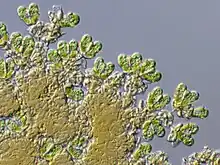 Extant specimen | |
|
Striatella[18] |
|
|
Very rare to abundant in the upper sections |
|
Brown algae, type genus of the family Striatellaceae in the Striatellales. These brown algae diatoms are associated with either brackish or marginal marine environments. |
|
|
|
Abundant but limited to the lowermost layer in Levka-1 borehole; Abudant to rare in Sorthat beds & Korsodde |
|
Affinities with the family Zygnemataceae. |
||
|
|
Very rare and limited to the lower layers |
|
Affinities with the family Zygnemataceae. A genus derived from freshwater filamentous or unicellular, uniseriate (unbranched) green algae. |
||
|
|
Rare to Abundant but limited to the lower-middle section |
|
Affinities with the family Zygnemataceae. |
||
|
Ovoidites[18] |
|
|
Very rare with peaks in the middle layers |
|
Affinities with the family Zygnemataceae. A genus derived from freshwater filamentous or unicellular, uniseriate (unbranched) green algae. |
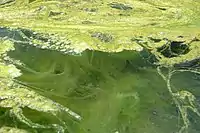 Extant Spirogyra; Ovoidites may be derived from a similar genus |
|
Crassosphaera[18] |
|
|
Very rare and limited to middle section |
|
Affinities with the family Pycnococcaceae. |
|
|
Pterospermella[18] |
|
|
Very rare and limited to middle section |
|
Affinities with the family Pterospermataceae. |
|
|
Leiosphaerida[18] |
|
|
Very abundant either on the lower middle or upper sections, very rare or absent in all other layers |
|
Affinities with the family Prasinophyceae. |
|
|
Cymatiosphaera[18] |
|
|
Very rare with peak in middle-upper layers in Levka-1 borehole; Very rare and limited to the lowermost layers in Sorthat beds |
|
Affinities with the family Pterospermopsidaceae. |
|
|
Tasmanites[18] |
|
|
Abudant to very rare, limited to the middle layers |
|
Affinities with the family Pyramimonadaceae. Found on shoreface and shoreface–offshore transition zone deposits. |
|
|
Veryhachium[18] |
|
|
Very rare and limited to the lower layers |
|
A dinoflagellate, member of the Dinophyceae. |
|
|
Luehndea[18] |
|
|
Abundant but only present in the middle section |
|
A dinoflagellate, member of the Luehndeoideae. It establishes the Luehndea spinosa zone; the age of this zone is late Pliensbachian to early Toarcian. |
|
|
Korystocysta[18] |
|
|
Very rare and only present in the middle section |
|
A dinoflagellate, member of the Cribroperidinioideae. |
|
|
|
Very rare and only present in the middle section |
|
A dinoflagellate, type genus of the Mancodinioideae. |
||
|
|
Rare to Abundant but limited to the lower-middle section |
|
A dinoflagellate, member of the family Gonyaulacales. |
||
|
|
Abudant in the lower section in Levka-1; Very abundant in the middle-upper sections in Sorthat beds and Korsodde |
|
A dinoflagellate, member of the family Nannoceratopsiaceae. It is characteristic of marine deposits. The presence of N. gracilis, N. senex and N. triceras, and common occurrence of Botryococcus is interpreted as indicating a lagoon succession overlying a transgressive surface and signals a rise in relative sea level. |
||
|
Micrhystridium[18] |
|
|
Abundant but limited to the middle section |
|
An acritarch, familia incertae sedis |
|
|
Baltisphaeridium[18] |
|
|
Very rare and limited to the middle layers |
|
An algal acritarch, probably related to freshwater red algae, similar to extant Florideophyceae (for example, Hildenbrandia) or Batrachospermales (Batrachospermum) and Thoreales. |
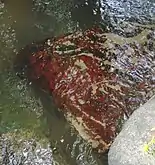 Extant Hildenbrandia; Baltisphaeridium may be derived from a similar genus |
|
Rotundus[18] |
|
|
Abundant to very abundant but limited to the lower section |
|
An algal palynomorph unique to the setting and probably related to freshwater red algae; similar to extant Batrachospermales. |
 Extant Batrachospermum |
Terrestrial palynology
In Early Toarcian carbonates, local bulk organic matter and wood fragments have been associated with carbon cycle perturbations, shedding light on the reaction of the continental biota to the Toarcian oceanic anoxic event, which accompanied large-scale volcanism.[29] There are several changes to the woody vegetation in the wood-derived carbon, with pollen assemblages dominated by pollen types in the Sciadopityaceae and Miroviaceae, such Cerebropollenites associated with cycad pollen types (Chasmatosporites) and the hirmeriellaceous Corollina.[29] The local palynology has shown the terrestrial changes of the local flora. In the Pliensbachian the dominant palynofacies were ones in the Cupressaceae such as Perinopollenites, along with cycads such as Cycadopites, found in mid-latitude Mediterranean climates.[30] Then, at the start of the event the local pollen assemblages show a shift to spore-rich layers, showing a long-term increase in ferns and lycophytes, an indicator of more humid conditions.[30] Finally, after the Toarcian anoxic event, the Sorthat Formation showed an abrupt rise of pollen of Hirmeriellaceae such as Corollina and specially Spheripollenites, both indicators of semidesertic to dry Mediterranean climates, implying an abrupt warming event coeval with the changes happening at sea.[30]
Bryophyta
| Genus | Species | Stratigraphic position | Abundance | Material | Notes | Images |
|---|---|---|---|---|---|---|
|
|
Very rare and present in certain intervals |
|
Incertae sedis; affinities with Bryophyta. This spore is found in Jurassic sediments associated with the polar regions. The Sorthat Formation is among its southernmost locations. |
||
|
|
Very rare and only in a few layers, with a few layers of very abundant presence in the middle |
|
Affinities with the family Notothyladaceae in the Anthocerotopsida. Hornwort spores. |
).png.webp) Extant Notothylas specimens; Foraminisporis probably come from similar genera. | |
|
|
Very rare and only in a few layers, with a few layers of very abundant presence in the middle |
| |||
|
|
Very rare and only in the middle layers |
| |||
|
|
Very rare with an abundant peak in the middle in Levka-1; very rare and limited to lower layers in Sorthat beds and Korsodde |
|
Affinities with the family Sphagnaceae in the Sphagnopsida. "Peat moss" spores, related to genera such as Sphagnum that can store large amounts of water. |
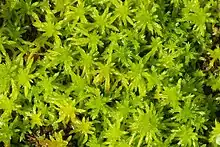 Extant Sphagnum specimens; Stereisporites, Sculptisporis and Rogalskaisporites probably come from similar genera | |
|
|
Very rare in the lower layers and absent in the youngest layers, with peak moderately abundant in the middle in Levka-1; very rare and limited to lower middle and uppermost layers in Sorthat beds and Korsodde |
| |||
|
|
Abudant in the lowermost layer to very rare or absent in the upper ones |
| |||
|
|
Very rare and only in a few layers of very abundant presence in the uppermost section |
|
Affinities with the family Encalyptaceae in the Bryopsida. Branching moss spores, indicating high water-depleting environments. |
_2281.JPG.webp) Extant Encalypta specimens; Staplinisporites probably come from similar genera |
Lycophyta
| Genus | Species | Stratigraphic position | Abundance | Material | Notes | Images |
|---|---|---|---|---|---|---|
|
|
Very rare and limited to the lowermost layer |
|
Affinities with the family Lycopodiaceae in the Lycopodiopsida. Lycopod spores, related to herbaceous to arbustive flora common in humid environments. |
 Extant Lycopodium specimens. Genera like Sestrosporites, Camarozonosporites, Retitriletes, Lycopodiumsporites and Semiretisporis probably come from a similar plant | |
|
|
Very rare |
| |||
|
|
Very rare in the lower layers to moderately abundant in the upper |
| |||
|
|
Peak in the upper middle, very abundant to very rare in the lowermost and uppermost layers in Levka-1; absent to abundant in upper layers in Korsodde |
|
Affinities with the Selaginellaceae in the Lycopsida. Herbaceous lycophyte flora, similar to ferns, found in humid settings. This family of spores are also the most diverse in the formation. |
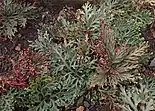 Extant Selaginella, typical example of Selaginellaceae. Genera like Anapiculatisporites or Densoisporites probably come from a similar or a related Plant | |
|
|
Very rare and in a few samples in Levka-1; abundant but only in the lowermost layer in Sorthat beds; very rare in Korsodde section |
| |||
|
|
Very rare and only in a few layers, with an exceptional peak in the middle upper section |
| |||
|
|
Very rare and only in the middle layers |
| |||
|
|
Abundant only in the middle upper section; absent in all other levels |
| |||
|
|
Rare and only in the lower layers in the Sorthat beds; rare in lower layers to relatively common in upper ones in Korsodde |
|
Equisetales
| Genus | Species | Stratigraphic position | Abundance | Material | Notes | Images |
|---|---|---|---|---|---|---|
|
|
Abudant in the upper section, rare to not present in the underliying layers in Levka-1; very rare and only in the middle in Sorthat beds; abundant to very abundant in the middle Korsodde section |
|
Affinities with the Calamitaceae in the Equisetales. Horsetails are herbaceous flora found in humid environments and are flooding-tolerant. In the sections of the formation such as Korsodde, this genus has small peaks in abundance in the layers where more Equisetites stems are found. |
 Reconstruction of the genus Calamites, found associated with Calamospora |
Pteridophyta
| Genus | Species | Stratigraphic position | Abundance | Material | Notes | Images |
|---|---|---|---|---|---|---|
|
|
Moderately to abudant in the middle layers in Levka-1; very rare and only in middle to upper layers in Sorthat beds and Korsodde |
|
Incertae sedis; affinities with the Pteridophyta |
||
|
|
Very rare and only in a few upper layers |
| |||
|
|
Very rare and only in a few layers |
| |||
|
|
Very rare and only in a few uppermost layers |
| |||
|
|
Very rare and limited to the middle |
| |||
|
|
Rare and in concrete samples in Korsodde; very rare and only in the middle in Levka-1 |
| |||
|
|
Abudant throughout the interval in Levka-1; moderately common under to abundant in the upper Sorthat beds; rare or not present in lower to moderlately common in upper Korsodde |
| |||
|
|
Very rare and only in a few layers |
| |||
|
|
Only in the uppermost layers and very rare |
|
Affinities with the Callistophytaceae in the Callistophytales. Spores from large arboreal to arbustive ferns. |
||
|
|
Very rare and in concrete samples in Levka-1 & Sorthat beds; abundant but limited to lower layers in Korsodde |
|
Affinities with the Ophioglossaceae in the Filicales. Fern spores from lower herbaceous flora. |
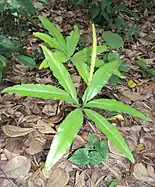 Extant Helminthostachys specimens; Lycopodiacidites probably comes from similar genera or maybe a species from the genus | |
|
|
Very rare and only in a few layers |
|
Affinities with the family Lygodiaceae in the Polypodiopsida. Climbing fern spores. |
.gif) Extant Lygodium; Lygodioisporites probably comes from similar genera or maybe a species from the genus | |
|
|
Very rare and only in a few layers |
|
Affinities with the family Dennstaedtiaceae in the Polypodiales. Forest fern spores. |
.jpg.webp) Extant Dennstaedtia specimens; Leptolepidites probably comes from similar genera | |
|
|
Moderately abundant |
|
Affinities with the family Osmundaceae in the Polypodiopsida. Near fluvial current ferns, related to the modern Osmunda regalis. |
_-_Cape_St._Mary's_Ecological_Reserve%252C_Newfoundland_2019-08-10.jpg.webp) Extant Osmunda specimens; Baculatisporites and Todisporites probably come from similar genera or maybe a species from the genus | |
|
|
Very rare and only in the middle layers in Levka-1; very rare and only in the uppermost section in Sorthat beds |
| |||
|
|
Abundant in the lower middle section, very rare in upper Levka-1; very rare and only in the middle in Sorthat beds |
|
Affinities with the Pteridaceae in the Polypodiopsida. Forest ferns from humid ground locations. |
.jpg.webp) Extant Pityrogramma specimens; Contignisporites and Manumia probably come from similar genera or maybe a species in the genus | |
|
|
Very rare and only in the lower layers |
|
Affinities with the genus Saccoloma, type representative of the family Saccolomataceae. This fern spore resembles those of the living genus Saccoloma, being probably from a pantropical genus found in wet, shaded forest areas. |
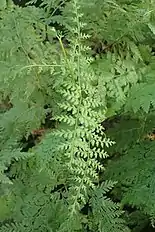 Extant Saccoloma specimens; Annulispora probably comes from similar genera or maybe a species in the genus | |
|
|
Very rare and only in the lowermost layers |
|
Affinities with the family Cyatheaceae in the Cyatheales. Arboreal fern spores. |
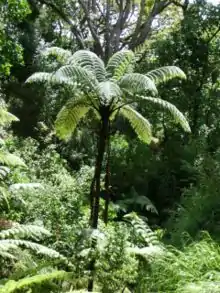 | |
|
|
Very rare and only in a few upper layers |
| |||
|
|
Very rare down to moderately abundant in Levka-1; very rare and only in upper layers in Sorthat beds and Korsodde |
|
Affinities with the genus Dicksoniaceae in the Polypodiopsida. Tree fern spores. |
_C.Chr._by_Jason_Hollinger_001.jpg.webp) | |
|
|
Very rare and in a few samples |
|
Affinities with the Gleicheniales in the Polypodiopsida. Fern spores from low herbaceous flora. |
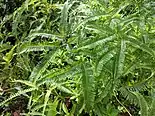 Extant Gleichenia specimens; Gleicheniidites and Iraqispora probably come from similar genera or maybe a species in the genus | |
|
|
Very rare and only in a few layers with a few layers of very abundant presence in the middle |
| |||
|
|
Very rare and in the lower layers only in Levka-1; very rare but also in upper layers in Sorthat beds and Korsodde |
|
Affinities with the Marattiaceae in the Polypodiopsida. Fern spores from low herbaceous flora. |
.jpg.webp) Extant Marattia specimens; Marattisporites probably comes from similar genera |
Peltaspermales
| Genus | Species | Stratigraphic position | Abundance | Material | Notes | Images |
|---|---|---|---|---|---|---|
|
|
Very rare and only in the lower to middle layers in Levka-1; abundant to very abundant in Sorthat beds and Korsodde |
|
Affinities with the families Peltaspermaceae, Corystospermaceae or Umkomasiaceae in the Peltaspermales. Pollen of uncertain provenance that can be derived from any of the members of the Peltaspermales. The lack of distinctive characters and poor conservation make this pollen difficult to classify. Arboreal to arbustive seed ferns. |
||
|
|
Very rare and in concrete layers |
| |||
|
|
Very rare and only in the lower layers |
|
From the family Caytoniaceae in the Caytoniales. Caytoniaceae are a complex group of Mesozoic fossil floras that may be related to both Peltaspermales and Ginkgoaceae. |
Erdtmanithecales
| Genus | Species | Stratigraphic position | Abundance | Material | Notes | Images |
|---|---|---|---|---|---|---|
|
|
Abudant but limited to lower layers |
|
Type pollen of the Erdtmanithecales, related to the Gnetales. Thick tectum, infratectum of small granules, indistinct or absent foot layer. Originally thought to come from angiosperms, then suggested to come from arbustive Bennettites. It was recently found to come from Eucommiitheca, a member of the enigmatic Erdtmanithecales, reinterpreted as an unusual gymnosperm grain with a single distal colpus flanked by two subsidiary lateral colps. Is very similar to the pollen of the extant Ephedra and Welwitschia (mainly on the basis of the granular structure of the exine).[31] |
Cycadophyta
| Genus | Species | Stratigraphic position | Abundance | Material | Notes | Images |
|---|---|---|---|---|---|---|
|
|
Abundant lower to very abundant upper |
|
Affinities with the family Zamiaceae in the Cycadales. It is among the most abundant flora recovered on the upper section of the coeval Rya Formation, and was found to be similar to the pollen of the extant Encephalartos laevifolius.[32] |
 Extant Encephalartos laevifolius. Chasmatosporites may come from a related plant | |
|
|
Abudant but limited to lower layers in Levka-1; abundant to very abundant in Sorthat beds and Korsodde |
|
Affinities with the family Cycadaceae in the Cycadales. The structure of the exine of Clavatipollenites hughesii from Jurassic deposits is fundamentally different from that of Cretaceous grains referred to the same species, confirming observations made previously on the basis of analysis under the light microscope and suggesting a possible derivation from cycadalean rather than angiospermous plants.[33] |
 Extant Cycas platyphylla. Clavatipollenites may come from a related plant |
Bennettitales
| Genus | Species | Stratigraphic position | Abundance | Material | Notes | Images |
|---|---|---|---|---|---|---|
|
Cycadopites[30] |
|
|
Very abundant but present only in the uppermost sections |
|
Affinities with the family Cycadaceae and Bennettitaceae. It has been found associated with the Bennetite pollen cone Bennettistemon. It increases towards the Toarcian section. |
Ginkgoales
| Genus | Species | Stratigraphic position | Abundance | Material | Notes | Images |
|---|---|---|---|---|---|---|
|
|
Abundant but limited to the middle layers |
|
Affinities with the family Karkeniaceae and Ginkgoaceae in the Ginkgoales. Had been considered pollen of Chloranthaceae but is likely from Ginkgoales, which can have similar features |
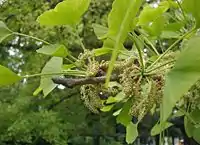 Extant Ginkgo, the only surviving member of the Ginkgoaceae. Monosulcites pollen is similar to the pollen of this extant species. |
Coniferophyta
| Genus | Species | Stratigraphic position | Abundance | Material | Notes | Images |
|---|---|---|---|---|---|---|
|
|
Very rare and limited to the middle layers |
|
Affinities with the family Pinaceae in the Pinopsida. Conifer pollen from medium to large arboreal plants. |
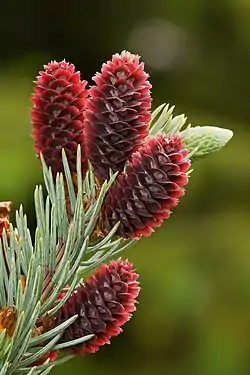 | |
|
|
Abundant to very abundant with intercalations of absence |
| |||
|
|
Rare to very rare and limited to the lower middle and uppermost layers in Levka-1; peak of abundance in middle layers in Sorthat beds and Korsodde |
| |||
|
|
Abundant to very abundant |
|
Affinities with both Sciadopityaceae and Miroviaceae in the Pinopsida. This pollen's resemblance to extant Sciadopitys suggest that Miroviaceae may be an extinct lineage of Sciadopityaceae-like plants.[34] |
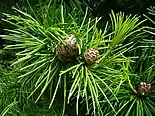 Extant Sciadopitys. Cerebropollenites likely come from a related plant | |
|
|
Very rare and limited to upper layers |
|
Affinities with the family Cupressaceae in the Pinopsida. Pollen that resembles that of extant genera such as the genus Actinostrobus and Austrocedrus, probably derived from dry environments. |
 | |
|
|
Intercalations of very abudant presence in some layers with others of total absence in Levka-1; very abudant in all layers in Sorthat beds and Korsodde |
| |||
|
|
Very rare in lower layers to dominant (95% of total) in upper ones |
|
Affinities with the Hirmeriellaceae in the Pinopsida. Spheripollenites psilatus composes up to 95% of the Lower Toarcian section and is correlated with Toarcian carbon cycle anomalies including the oceanic anoxic event, suggesting dry climates.[35] |
||
|
|
Very abundant, but with intercalations of layers of total absence in Levka-1; very abundant and almost dominant in some samples in Sorthat beds and Korsodde |
| |||
|
|
Very rare and only in upper layers |
|
Affinities with the family Krassiloviaceae in the Pinales. Unlike other species in the genus, A. australis usually seems to associate with Podozamites. Conifer pollen from medium to large arboreal plants. |
||
|
|
Very rare and only in a few layers |
|
Affinities with the family Araucariaceae in the Pinales. Conifer pollen from medium to large arboreal plants. |
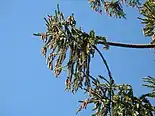 Extant Araucaria. Callialasporites may come from a related plant |
Fossil wood
Is also common to found wood from the nearshore deposits of Korsodde, with two sets: macroscopic wood, recognizable to the naked eye, up to branch-sized; and microscopic wood (0.25 to 1 mm average dimension).[36] The wood has not been assigned to a concrete genu. This wood shows isotopic patterns similar to those found in the Late Palaeocene thermal maximum, and has allowed measurement of the higher atmospheric CO2 concentrations of this interval.[36] The formation includes:
- Woody material (humotelinite)
- Woody plant tissues
- Coalified pieces of wood
- Large coalified wood fragments
- Isolated logs
| Genus | Species | Stratigraphic position | Material | Notes | Images |
|---|---|---|---|---|---|
|
|
|
Affinities with Hirmeriellaceae in the Pinales. Originally identified as Brachyoxylon rotnaensis, now thought to be a synonym of Simplicioxylon.[38] Wood from these conifers is also found in the Hettangian–Sinemurian Rønne Formation and the Toarcian Úrkút Manganese Ore Formation. |
||
|
|
|
Affinities with Hirmeriellaceae or Araucariaceae in the Pinales. Originally Araucarioxylon württembergica. This genus is usually associated with leaf-bearing twigs referred to as Pagiophyllum, abundant in the Sorthat Formation. |
Amber
| Type | Location | Material | Notes |
|---|---|---|---|
|
Sorthat beds |
Amber fragments |
B. Eske Koch corroborated the presence of amber drops in the Sorthat Formation. This record represents one of the few worldwide from Jurassic layers.[39] This amber was quoted as derived from Coniferales indet.[39] | |
Plant macrofossils
The main deposits of macroflora are the Hasle clay pit and the Korsodde section. The flora was originally stated to be coeval with the Rhaetian–Hettangian floras of Sweden, but found later to be Pliensbachian–Toarcian.[40] Möller did the two major studies on the local flora, with 68 species described, 50% of them ferns.[41][42] The Late Pliensbachian section is dominated by ferns, suggesting a warm and humid climate, which fits with the palaeolatitude of Bornholm, firmly within the Jurassic warm biome.[40] But the presence of Ginkoaleans and absence of large-leafed Bennettites suggest this warm climate was seasonal. Ferns and sphenophytes in the assemblage are interpreted to have occupied the forest floor. Bennettites were mid-storey shrubs, and conifers, such as Pagiophyllum, together with ginkgoaleans, make up the main arboreal flora.[40] All the flora developed on a meandering river system with well-vegetated marshy flood plains.[40] The Toarcian section shows a radical change on the local flora, as Hirmeriellaceae conifers take over the role of dominant flora, representing 95% of the pollen recovered, along with the rise of seed ferns, Bennettites and Czekanowskiales.[43] The dominance of Pagiophyllum and its related pollen Corollina torosus indicate high temperature and aridity with seasonal wildfires (though some sections show a low coal ratio and are derived from slightly more humid environments), with rare occurrences of Brachyphyllum and one Cyparissidium.[43]
| Genus | Species | Stratigraphic position | Material | Notes | Images |
|---|---|---|---|---|---|
|
|
|
Affinities with Equisetaceae in the Equisetales. Related equisetalean stems are found in the Hettangian strata along Skane, Sweden. In the lagoonar sections there is correlation between bioturbation and transported Equisetites stems.[30] Local Equisetales reached a considerable size, comparable to modern subtropical bamboos, close to lakes and in the wettest environments.[25] |
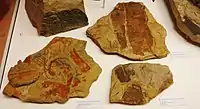 Equisetites specimen | |
|
|
|
Affinities with Calamitaceae in the Equisetales. Related equisetalean stems are found in strata of the same age along Skane, Sweden. Based on analogies with morphologically similar extant Equisetum species, it is interpreted to represent a plant of consistently moist habitats, such as marshes, lake margins or forest understorey, normally developing dense thickets. |
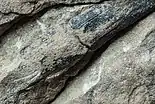 Neocalamites specimen | |
|
|
|
Affinities with Equisetidae in the Equisetales. |
||
|
|
|
Affinities with Selaginellaceae and Lycopodiidae in the Lycopodiales. It was originally described as Lycopodites falcatus. The leaves of this species are more prominently anisophyllous than in the Raheto-Hettangian S. coburgensis from Franconia.[48] |
||
|
|
|
Incertae ordinis in the Pteridophyta. Spiropteris is the name given to the fossil of a coiled, unopened fern leaf. |
||
|
|
|
Affinities with Osmundaceae in the Osmundales. Related to species commonly reported from the Triassic–Jurassic of southern Sweden. |
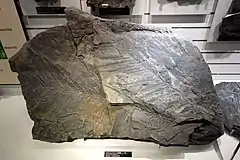 Cladophlebis nebbensis specimen | |
|
|
|
Affinities with Osmundaceae in the Osmundales. Specimens assigned to this morphothype have been found in the Middle Jurassic flora of Yorkshire, associated with Todites miospores, and were originally described as Asplenites cladophleboides. |
||
|
|
|
Affinities with Dicksoniaceae in the Cyatheales. The Lund material is dominated by ferns belonging to the genus Eboracia (28 specimens of E. lobifolia and 14 of another Eboracia sp.). The latter has smaller pinnules than E. lobifolia. |
||
|
|
|
Affinities with Dicksoniaceae in the Cyatheales. It show similarities with Sphenopteris longipinnata in the morphological outline of the leaflets and the keels of the pinnate axis. |
 Extant Dicksonia | |
|
|
|
Affinities with Polypodiales in the Polypodiidae. Common cosmopolitan Mesozoic fern genus. Recent research has reinterpreted it a stem group of the Polypodiales (closely related to the extant genera Dennstaedtia, Lindsaea, and Odontosoria).[50] |
.jpg.webp) Coniopteris specimen | |
|
|
|
Affinities with Dipteridaceae in the Polypodiales. Specimens from the same species have been found in the Hettangian Höör Sandstone at southern Sweden. |
 Hausmannia specimen | |
|
|
|
Affinities with Dipteridaceae in the Polypodiales. |
 Clathropteris meniscioides specimen | |
|
|
|
Affinities with Dipteridaceae in the Polypodiales. Dictyophyllum is a common dipteridacean genus of the mid-Mesozoic. |
 Dictyophyllum nilssonii specimen | |
|
|
|
Affinities with Dipteridaceae in the Polypodiales. |
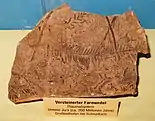 Thaumatopteris specimen | |
|
|
|
Affinities with Matoniaceae in the Gleicheniales. |
.jpg.webp) Phlebopteris specimen | |
|
|
|
Affinities with Matoniaceae in the Gleicheniales. |
||
|
|
|
Affinities with Marattiaceae in the Marattiopsida. |
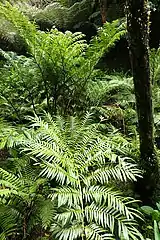 Extant Marattia specimen | |
|
|
|
Plant propagules that may be from Pteridospermatophyta, Vladimariales, Bennettitales or Pinales. Fruits or seeds of uncertain placement. |
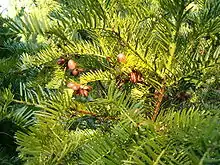 Cephalotaxus fruits. Some Carpolithes are similar conifer-derived propagules. | |
|
|
|
Affinities with Pteridospermae in the Pteridospermatophyta. |
||
|
|
|
Affinities with Caytoniaceae in the Pteridospermatophyta. Related to seed ferns present in the Rhaetic flora of Sweden. |
 Sagenopteris specimen | |
|
|
|
Affinities with Umkomasiaceae in the Pteridospermatophyta. Less common than other arboreal plants. |
||
|
|
|
Affinities with Umkomasiaceae in the Pteridospermatophyta. |
||
|
|
|
Affinities with Umkomasiaceae in the Pteridospermatophyta. |
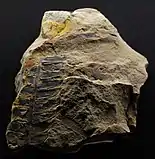 Ptilozamites specimen | |
|
Ctenozamites[51] |
|
|
|
Affinities with Umkomasiaceae in the Pteridospermatophyta. |
|
|
|
|
Affinities with Corystospermaceae in the Pteridospermatophyta. |
 Cycadopteris specimen | |
|
|
|
Affinities with Umaltolepidaceae in the Vladimariales. These belong to a group parallel to Gingkoaceans and derived probably from Umkomasiaceae. |
||
|
|
|
Affinities with Williamsoniaceae in the Bennettitales. Insufficient and incomplete material prevents certain assignment of Otozamites cf. reglei and Otozamites cf. mimetes |
.jpg.webp) Otozamites specimen | |
|
|
|
Affinities with Williamsoniaceae in the Bennettitales. |
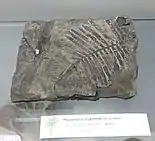 Pterophyllum specimen | |
|
|
|
Affinities with Williamsoniaceae in the Bennettitales. |
||
|
|
|
Affinities with Williamsoniaceae in the Bennettitales. |
_from_Whitby%252C_Estuarine_Series%252C_Middle_Jurassic_(L.8044)_%2540mcrmuseum_-NaturesLibrary_(21548076115).jpg.webp) Williamsonia "flower" | |
|
|
|
Affinities with Cycadeoidaceae in the Bennettitales. The most common and abundant bennetite on the formation. |
.jpg.webp) Nilssonia specimen | |
|
|
|
Affinities with Cycadeoidaceae in the Bennettitales. |
||
|
|
|
Affinities with Cycadidae in the Cycadopsida. |
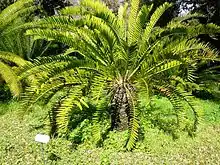 An extant cycad, Encephalartos longifolius | |
|
|
|
Affinities with Cycadales in the Cycadopsida. |
 Ctenis specimen | |
|
Butefia[55] |
|
|
|
Affinities with Cycadales in the Cycadopsida. Originally described as Podozamites ensiformis. |
|
|
|
|
Affinities with Ginkgoales in the Ginkgoopsida. |
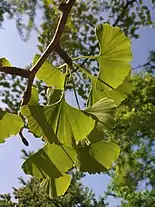 Extant Gingkoalean Ginkgo biloba | |
|
|
|
Affinities with Ginkgoaceae in the Ginkgoales. Seven species assigned to either Ginkgo or Ginkgoites have been reported from Latest Triassic to middle Jurassic strata of southern Sweden. |
 Ginkgoites sibirica reconstruction | |
|
|
|
Affinities with Karkeniaceae in the Ginkgoales. Unlike other plant specimens from the location, it is more characteristic of Middle Jurassic flora. |
 Baiera specimen | |
|
|
|
Affinities with Czekanowskiales in the Ginkgoales. This genus is related to flora from the Rhaetian–Hettangian boundary of Jameson Land, but also present in Romania. |
||
|
Solenites[43] |
|
|
|
Affinities with Czekanowskiales in the Ginkgoales. This species was described on the basis of individuals collected in Greenland from the Triassic–Jurassic boundary. |
|
|
|
|
Affinities with Czekanowskiales in the Ginkgoales. Linked to the Lower Liassic flora of Greenland. |
||
|
|
|
Affinities with Coniferales in the Coniferopsida. |
_06.jpg.webp) Extant conifers (Pinus) | |
|
|
|
Affinities with Araucariaceae or Hirmeriellaceae in the Pinales. P. kurrii (originally P. steenstrupi) is preferred as this species is characterised by relatively broad leaves inserted at high angles to the stem. P. peregrinum has been found on the Hettangian Rønne Formation associated with hirmeriellidaceous wood of Simplicioxylon. On the Toarcian levels, is the most common plant cuticle recovered locally. |
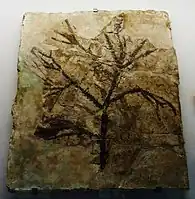 Pagiophyllum specimen | |
|
|
|
Affinities with Araucariaceae or Hirmeriellaceae in the Pinales. Is related to the Hettangian axis found in Scania, Sweden |
_(cropped).jpg.webp) Brachyphyllum specimen | |
|
Dactylethrophyllum[35] |
|
|
|
Affinities with Hirmeriellaceae in the Pinales. It is related to other representatives of the genus of the Toarcian of Italy and Lower Jurassic of Israel. Spheripollenites co-occurs with cuticles of Dactylethrophyllum ramonensis, and the species S. psilatus may be produced by the conifer genus Dactylethrophyllum.[35] |
|
|
|
|
Affinities with Hirmeriellaceae in the Pinales. The main genus of the Hirmeriellaceae, found in dry environments and probably fire tolerant. |
||
|
|
|
Affinities with Palissyaceae in the Palissyales. |
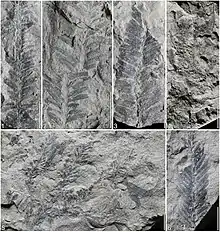 Stachyotaxus specimens | |
|
|
|
Affinities with Palissyaceae in the Palissyales. Descriptions of Palissya come mostly from coeval deposits in the Northern Hemisphere, based on a very few specimens from Sweden, Germany and America. |
||
|
|
|
Affinities with Schizolepisaceae in the Pinaceae. Placed in the Pinaceae on the basis of separated scales and bract scales. |
||
|
|
|
Affinities with Schizolepisaceae in the Pinaceae. This genus is found associated with Schizolepis on many places, making diverse authors to put both on Pinaceae. |
||
|
Pityocladus[58] |
|
|
|
Affinities with Schizolepisaceae in the Pinaceae. |
|
|
Lindleycladus[59] |
|
|
|
Affinities with Krassiloviaceae in the Voltziales. |
|
|
|
|
Affinities with Krassiloviaceae in the Voltziales. The local Podozamites show a great range of growth, reflecting tropical to subtropical conditions. |
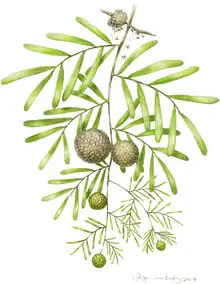 Podozamites reconstruction | |
|
|
|
Affinities with Cunninghamioideae in the Cupressales. Cunninghamia-like conifers belonging to half-evergreen trees. |
||
|
|
|
Affinities with Thujaceae in the Cupressales. It was originally described as Taxites? subzamioides, later merged with Elatocladus. |
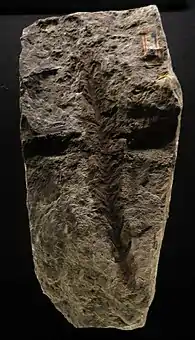 Elatocladus specimen | |
|
|
|
Affinities with Cupressoideae in the Cupressales. It matches with the Middle Jurassic Cyparissidium blackii from Yorkshire, England. |
||
|
|
|
Affinities with Taxaceae in the Pinales. Was first identified in Bornholm. Is similar to the cretaceous Taxus huolingolensis and extant Taxus in leaf gross morphology and has papillate abaxial cuticles, probably being close to this genus.[62] |
||
|
|
|
Affinities with Taxaceae in the Pinales. Originally described as Taxus jurassica. |
||
|
|
|
Affinities with Taxaceae in the Pinales. Known only from Bornholm and belongs to an extant genus. This species is related to the Middle Jurassic floras of Yorkshire. |
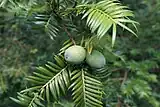 Extant Torreya specimen |
Fauna
Ichnofossils
| Genus | Species | Location | Material | Type | Origin | Notes | Images |
|---|---|---|---|---|---|---|---|
|
|
Dwelling traces |
|
Marine, brackish or freshwater unbranched U-shaped burrows having a subvertical orientation, with or without lining and passive fill. Are common on modern coastal environments. |
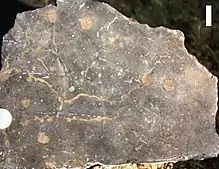 | ||
|
|
Cylindrical burrows |
Pascichnia |
|
Burrow-like ichnofossils referred to vermiform deposit-feeders. Sometimes considered a junior synonym of Palaeophycus.[64] |
 Planolites fossil | |
|
Palaeophycus[11] |
|
|
Cylindrical, predominantly horizontal to inclined burrows |
Domichnia |
|
Burrow-like ichnofossils. They occur in different size classes, 3, 5 and 10 mm in diameter. |
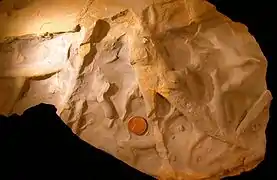 Palaeophycus fossil |
|
Bornichnus[11] |
|
|
Tubular traces |
Agrichnia |
|
Burrow-like ichnofossils. Exclusive to the Sorthat Formation, Bornichnus differs from Palaeophycus Hall in its tangled, contorted morphology and abundant branching. Small open burrows produced probably by farming worm-like animals (probably Polychaeta). Similar complicated burrow systems are produced by the polychaete Capitomastus cf. aciculatus. |
|
|
|
Cylindrical to subcylindrical burrows |
Domichnia |
|
Burrow-like ichnofossils made by organisms advancing along the bottom surface. Very narrow, vertical or subvertical, slightly winding unlined shafts filled with mud. Interpreted as dwelling structures of vermiform animals; specifically, the domichnion of a suspension-feeding worm or phoronidan, with certain Skolithos representing entrance shafts to more complicated burrows. |
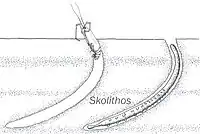 Skolithos ichnofosil reconstruction, with possible fauna associated | |
|
Cylindrichnus[11] |
|
|
Burrowing and track ichnofossils |
Domichnia |
|
Burrow-like ichnofossils, found only in the uppermost part of the section; probably represents Polychaeta burrows. |
|
|
|
Dwelling traces |
Fodinichnia |
|
Burrow-like ichnofossils. The level where this ichnogenus is more abundant is also composed of abundant fragments of spreite lamination, derived from the intersection with the ichnofossil. They are believed to be fodinichnia, with the organism adopting the habit of retracing the same route through varying heights of the sediment, which would allow it to avoid going over the same area. Believed to derive from annelid worms. |
 Teichichnus fossil | |
|
|
Tubular fodinichnia |
Fodinichnia |
|
Burrow-like ichnofossils. Large burrow-systems consisting of smooth-walled, essentially cylindrical components. Found in association with Teichichnus. |
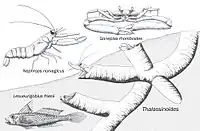 Thalassinoides burrowing structures, with modern related fauna, showing the ecological convergence and the variety of animals that left this Ichnogenus. | |
|
|
Tubular fodinichnia |
Fodinichnia |
|
Burrow-like ichnofossils. Interpreted as the feeding burrow of a sediment-ingesting animal. A more recent study has found that Scoloplos armiger and Heteromastus filiformis, occurring in the German Wadden Sea in the lower parts of tidal flats, make burrows that are homonymous with numerous trace fossils of the ichnogenus.[66] |
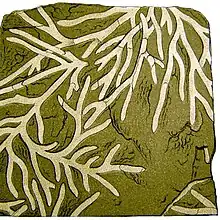 Illustration of Chondrites bollensis | |
|
|
Trace fossil |
Sequestrichnia |
|
Burrow-like ichnofossils. Vertical or oblique complex trace fossil composed of a bunch of spindle-shaped structures and associated tubes, typical of a restricted environment (?estuarine/lagoonal). The local Rosselia is similar to the ichnogenus Parahentzschelinia surlyki from the lower Jurassic of Greenland, which may be a junior synonym. This trace fossil is interpreted as made by a small deposit-feeding animal, living in a tube communicating with the sea floor. These traces are linked with shrimps or other aquatic arthropods, since the tunnels possess scratch patterns. |
||
|
|
U-shaped burrows |
Domichnia |
|
Burrow-like ichnofossils. Most show only protrusive spreit, like the local ones, produced under predominantly erosive conditions where the organism was constantly burrowing deeper into the substrate as sediment was eroded from the top. Most Diplocraterion show only protrusive spreiten, like the local ones produced under predominantly erosive conditions where the organism was constantly burrowing deeper into the substrate as sediment was eroded from the top. |
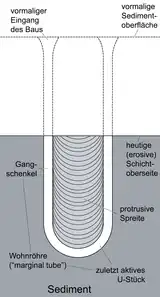 Diplocraterion parallelum diagram | |
Annelida
| Genus | Species | Stratigraphic position | Material | Notes | Images |
|---|---|---|---|---|---|
|
"Cycadeospermum"[68] |
|
|
Cocoons |
Freshwater Clitellata cocoons (Oligochaeta and Hirudinea), identified with palynological residues. Also called "red eggs" and present on the estuarine series of Yorkshire. |
|
|
Dictyothylakos[68] |
|
|
Cocoons |
Freshwater Clitellata cocoons (Oligochaeta and Hirudinea), identified with palynological residues and through to be tridimensional nets of probable algal origin. They consist of fragmentary mesh-like networks of happiness threads composed of homogenous translucent material. They show the outer wall (hapsine) construction specific to clitellate annelids and lack an alytine (inner) layer. A disorderly meshwork of the hapsine layer and hapsine fibers of unequal thickness are diagnostic of the type species, D. pesslerae. The cocoons of D. pesslerae resemble specially those of modern leechs and are common on flooded basin sediments, which implies not only the presence of parasitic leeches, but also the presence of hosts, as has been confirmed in the case of the coeval Ciechocinek Formation, thanks to the presence of not only dinosaurs but also Dipnoi and other freshwater taxa. |
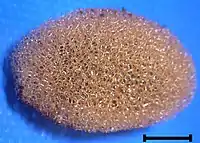 Leech cocoon .jpeg.webp) Placobdella, a leech |
Brachiopoda
| Genus | Species | Stratigraphic position | Ex Situ | Material | Notes | Images |
|---|---|---|---|---|---|---|
|
Homoeorhynchia[69] |
|
|
Moved from the parallel deposits of the Sorthat Formation to the Komorowo Formation, evident from massive erosion from post-mortem breakage in many cases. |
Numerous specimens |
A brackish brachiopodan, member of Rhynchonellidae in the Rhynchonellida. The only major brachiopod described in the region. |
Bivalvia
| Genus | Species | Stratigraphic position | Ex Situ | Material | Notes | Images |
|---|---|---|---|---|---|---|
|
|
Moved from the parallel deposits of the Sorthat Formation to the Komorowo Formation, evident from massive erosion from post-mortem breakage in many cases. |
Shells |
A brackish clam, member of the Inoceramidae in the Myalinida. Represented by fragmentaryShells. |
||
|
Isocyprina[69] |
|
Shells |
A brackish clam, member of the Arcticidae in the Veneroidei. |
|||
|
Nicaniella[69] |
|
Shells |
A brackish clam, member of the Astartidae in the Carditida. |
|||
|
Sowerbya[69] |
|
Shells |
A brackish nut clam, member of the Sowerbyidae in the Cardiida. |
|||
|
Tancredia[69] |
|
Shells |
A brackish nut clam, member of the Tancrediidae in the Cardiida. |
|||
|
Nucula[69] |
|
Shells |
A brackish nut clam, member of the Nuculidae in the Nuculida. |
|||
|
Leda[69] |
|
|
Present both ex situ and in situ |
Shells |
A brackish nut clam, member of the Nuculidae in the Nuculida. |
|
Scaphopoda
| Genus | Species | Stratigraphic position | Ex Situ | Material | Notes | Images |
|---|---|---|---|---|---|---|
|
|
Moved from the parallel deposits of the Sorthat Formation to the Komorowo Formation, evident from massive erosion from post-mortem breakage in many cases. |
Shells |
A saltwater tusk shell (Scaphopoda), member of the family Dentaliidae in the Dentaliida. |
||
|
Dentalium[69] |
|
Shells |
A saltwater tusk shell (Scaphopoda), member of the family Dentaliidae in the Dentaliida. |
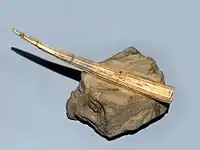 | ||
Gastropoda
| Genus | Species | Stratigraphic position | Ex Situ | Material | Notes | Images |
|---|---|---|---|---|---|---|
|
Rhynchocerithium[70] |
|
|
Moved from the parallel deposits of the Sorthat Formation to the Komorowo Formation, evident due to massive erosion from post-mortem breakage in many cases. |
Numerous shells |
A brackish snail, member of the Procerithiidae in the Caenogastropoda. The local assigned Francocerithium? sp. and Francocerithium kochi from the older Pliensbachian stratum may be all Rhynchocerithium sp. |
|
|
Shells |
A brackish snail, member of the Procerithiidae in the Caenogastropoda. |
||||
|
Ptychomphalus[70] |
|
Shells |
A brackish snail, member of the Eotomariidae in the Pleurotomarioidea. The species may be identical to the questionable "Ptychomphalus" theodorii. |
|||
|
Shells |
A brackish snail, member of the Neritopsidae in the Neritoina. |
||||
|
Katosira[70] |
|
Shells |
A brackish snail, member of the Settsassiidae in the Hypsogastropoda. Turriculate, slenderShells. |
|||
|
Maturifusus[70] |
|
Shells |
A brackish snail, type member of the Maturifusidae in the Hypsogastropoda. Limited to the Grimmen clay pit. |
|||
|
Cylindrobullina[70] |
|
Shells |
A sea snail, type genus of the Cylindrobullinidae in the Architectibranchia. |
|||
|
Sinuarbullina[70] |
|
Shells |
A brackish snail, member of the Tubiferidae in the Heterostropha. |
|||
|
Tricarilda[70] |
|
Shells |
A minute brackish snail, member of the Mathildidae in the Allogastropoda. The Tricarilda? sp. of Grimmen may be the same as the assigned specimens Tricarilda? sp. of Reinberg. |
|||
|
Conusella[70] |
|
Shells |
A brackish snail, member of the Tofanellidae in the Mathildoidea. |
|||
|
Actaeonina[70] |
|
Shells |
A brackish snail, member of the Acteoninidae in the Prosobranchia. |
|||
|
Shells |
A brackish snail, member of the Prosobranchia. |
||||
|
Ovactaeonina[70] |
|
Shells |
A brackish snail, member of Acteoninidae in the Prosobranchia. The most diverse genus of snail in the Sorthat Formation. |
|||
|
Colostracon[70] |
|
Shells |
A brackish snail, member of the Acteoninidae in the Prosobranchia. |
|||
|
Bandellina[70] |
|
Shells |
A brackish snail, member of the Cornirostridae in the Heterobranchia. |
|||
|
Levipleura[70] |
|
Several hundred shells |
A brackish snail, member of the Zygopleuridae in the Murchisoniina. The most abundant in the German realm. |
|||
|
Falsoebala[70] |
|
Shells |
An opisthobranch brackish snail, member of the Murchisonellidae in the Pyramidelloidea. Mostly limited to northern deposits. |
|||
|
Mistelgauia[70] |
|
Shells |
A brackish snail, member of the Eucyclidae in the Seguenzioidea. |
|||
|
Eucyclus[70] |
|
Shells |
A brackish snail, member of the Eucyclidae in the Seguenzioidea. |
|||
|
Shells |
A brackish snail, member of the Eucyclidae in the Seguenzioidea. |
||||
|
Shells |
A brackish false top snail, member of the Trochoidea. |
||||
|
Lewisiella[70] |
|
Shells |
A brackish false top snail, member of the Ataphridae in the Trochoidea. Also known from Franconia, with only 10 specimens from Grimmen. |
|||
Crustacea
| Genus | Species | Stratigraphic position | Material | Notes | Images |
|---|---|---|---|---|---|
|
|
|
A controversial, possible marine, brackish, freshwater or even terrestrial crab, whose classification is problematic. Described as Goniodromites liasicus and suggested to be a member of the family Goniodromitidae, but recent studies suggest affinities with Eubrachyura. It is one of the oldest reported crabs know. Probably lived in association with the parallel deposits of the formation and probably one of the makers of the burrows recovered. It was suggested to come from younger deposits, but recent works confirm a Lower Toarcian age.[72] Both specimens found have similar morphological traits with the unrelated extant members of the family Gecarcinidae, which has led to the suggestion that this may be the oldest example of a semiterrestrial brachyuran. The parallel environments of the Sorthat Formation probably allow this lifestyle, although this is all speculative.[72] |
.jpg.webp) Morphological traits of Sorthatdromites are similar to those of the extant unrelated Gecarcoidea, which has led to suggest that the parallel environment of the formation allow to an early terrestrialization of eubrachyurans | |
Chondrichthyes
| Genus | Species | Stratigraphic position | Ex Situ | Material | Notes | Images |
|---|---|---|---|---|---|---|
|
|
Moved from the parallel deposits of the Sorthat Formation to the Komorowo Formation, evident due to massive erosion from post-mortem breakage in many cases. |
|
A marine, brackish or freshwater shark, type genus of the family Hybodontidae in the Hybodontiformes. This genus occurs mostly at Pigstraale, and the shape of its cross section is quite similar to that of Hybodus minor. In addition there is a large number of teeth, most consistent with the depicted species. Other species occur; among the material found were teeth that resemble the species Hybodus grossiconus and Hybodus cloacinus |
 | |
|
Lonchidiidae[73] |
|
|
A brackish or frashwater shark, member of the family Lonchidiidae in the Hybodontiformes. Dental features resembling those of the lonchidiid Parvodus.[73] |
|||
|
|
A brackish or freshwater shark, member of the family Lonchidiidae in the Hybodontiformes. Morphology and ornamentation pattern seen in these teeth warrants an inclusion in the genus Lissodus, specifically L. johnsonorum.[73] |
||||
|
Palidiplospinax[73] |
|
|
A marine, brackish or freshwater shark, member of the family Palaeospinacidae in the Synechodontiformes. Fits well with dental characteristics described for lateral teeth of P. enniskilleni.[73] |
|||
|
Sphenodus[73] |
|
|
A marine, brackish or freshwater shark, member of the family Orthacodontidae in the Synechodontiformes. Similar to teeth described from the Rya Formation.[73] |
 | ||
|
|
A marine, brackish or freshwater shark, member of the family Paraorthacodontidae in the Synechodontiformes. The Grimmen teeth, especially the lateral ones, indicate close similarities to those of P. kruckowi.[73] |
||||
|
|
A marine, brackish or freshwater shark, member of the family Orectolobiformes in the Galeomorphii. Cannot be assigned to a genus due to its very generalized morphology, which otherwise displays close similarities to teeth of the extant genus Hemiscyllium.[73] |
 | |||
|
|
A marine shark, type member of the family Agaleidae in the Euselachii. |
||||
|
Notidanoides[73] |
|
|
A marine or brackish shark, member of the family Crassodontidanidae in the Hexanchoidei. Resembles the genus in its edge serrations.[73] |
|||
|
|
A brackish or freshwater ray, incertae sedis in the Rajiformes. It appears to have used different, less specialized and probably more opportunistic feeding strategies, as suggested by the gracile and high tooth morphology.[73] |
 | |||
Actinopteri
| Genus | Species | Stratigraphic position | Material | Notes | Images |
|---|---|---|---|---|---|
|
|
|
A brackish or freshwater ray-finned fish, incertae sedis in the Pycnodontiformes. Moved from the parallel deposits of the Sorthat Formation to the Komorowo Formation, evident from massive post-mortem breakage in many cases. The worn nature is notable on this one, which is impossible to assign to a genus due to its abrasion.[74] |
||
See also
- List of fossiliferous stratigraphic units in Denmark
- Neringa Formation, Lithuania
- Pliensbachian formations
- Blanowice Formation, Southern Poland
- Clarens Formation, South Africa
- Mizur Formation, North Caucasus
- Fernie Formation, Canada
- Hasle Formation, Denmark
- Kota Formation, India
- Los Molles Formation, Argentina
- Mawson Formation, Antarctica
- Rotzo Formation, Italy
- Whiteaves Formation, British Columbia
- Navajo Sandstone, Utah
- Kandreho Formation, Madagascar
- Kota Formation, India
- Cattamarra Coal Measures, Australia
References
- Michelsen, O.; Nielsen, L. H.; Johannessen, P. N.; Andsbjerg, J.; Surlyk, F. (2003). "Jurassic lithostratigraphy and stratigraphic development onshore and offshore Denmark" (PDF). Geological Survey of Denmark and Greenland (GEUS) Bulletin. 1 (1): 145–216. doi:10.34194/geusb.v1.4651. S2CID 126907584. Archived (PDF) from the original on 8 September 2021. Retrieved 8 September 2021.
- Gry, H.; Jørgart, T.; Poulsen, V. (1969). "Lithostratigraphy and sedimentary evolution of the Triassic, Jurassic and Lower Cretaceous of Bornholm, Denmark". Mineralogisk Mus. 6 (1).
- Gravesen, P. (1982). "Lithostratigraphy and sedimentary evolution of the Triassic, Jurassic and Lower Cretaceous of Bornholm, Denmark". Serie B / Danmarks geologiske undersøgelse. 1 (1).
- Gry, Helge (1969). "Megaspores from the Jurassic of the island of Bornholm, Denmark" (PDF). Meddelelser Fra Dansk Geologisk Forening. 19 (1): 69–89. Archived (PDF) from the original on 26 September 2021. Retrieved 8 September 2021.
- Bergelin, I.; Obst, K.; Söderlund, U.; Larsson, K.; Johansson, L. (2011). "Mesozoic rift magmatism in the North Sea region: 40 Ar/39 Ar geochronology of Scanian basalts and geochemical constraints". International Journal of Earth Sciences. 100 (4): 787–804. Bibcode:2011IJEaS.100..787B. doi:10.1007/s00531-010-0516-3. S2CID 128811834. Archived from the original on 2021-09-08. Retrieved 2021-09-08.
- Nielsen., L. H. (1987). "Progress report 1.1.1988. Biostratigraphy and organic geochemistry of the Mesozoic on Bornholm". DGU 215 Confidential Report. Geological Survey of Denmark. 31: 0–35.
- Koppelhus., E.B. (1988). "Catalogue of spores and pollen from the Lower–Middle Jurassic Bagå Formation on Bornholm, Denmark". DGU Confidential Report. Copenhagen: Geological 214 Survey of Denmark. 21: 42.
- Koppelhus, E.B.; Batten, D.J. (1992). "Megaspore assemblages from the Jurassic and lowermost Cretaceous of Bornholm, Denmark". Danmarks Geologiske Undersøgelse Serie A. 32: 81. doi:10.34194/seriea.v32.7052.
- Zimmermann, J.; Franz, M.; Schaller, A.; Wolfgramm, M. (2017). "The Toarcian-Bajocian deltaic system in the North German Basin: Subsurface mapping of ancient deltas-morphology, evolution and controls". Sedimentology. 65 (3): 897–930. doi:10.1111/sed.12410. S2CID 134553951. Archived from the original on 21 December 2021. Retrieved 8 September 2021.
- Barth, G.; Pieńkowski, G.; Zimmermann, J.; Franz, M.; Kuhlmann, G. (2018). "Palaeogeographical evolution of the Lower Jurassic: high-resolution biostratigraphy and sequence stratigraphy in the Central European Basin". Geological Society, London, Special Publications. 469 (1): 341–369. Bibcode:2018GSLSP.469..341B. doi:10.1144/SP469.8. S2CID 134043668. Retrieved 8 September 2021.
- Bromley, R. G.; Uchman, A. (2003). "Trace fossils from the Lower and Middle Jurassic marginal marine deposits of the Sorthat Formation, Bornholm, Denmark". Bulletin of the Geological Society of Denmark. 52 (1): 185–208. doi:10.37570/bgsd-2003-50-15. Retrieved 8 September 2021.
- Hoelstad, T. (1985). "Palynology of the Uppermost Lower to Middle Jurassic strata on Bornholm, Denmark" (PDF). Geological Society of Denmark, Bulletin (Meddelelser Fra Dansk Geologisk Forening). 30 (1): 34. Archived (PDF) from the original on 26 September 2021. Retrieved 8 September 2021.
- Graversen, O. (2004). "Upper Triassic–Lower Cretaceous seismic sequence stratigraphy and basin tectonics at Bornholm, Denmark, Tornquist Zone, NW Europe". Mar. Pet. Geol. 21 (1): 579–612. Bibcode:2004MarPG..21..579G. doi:10.1016/j.marpetgeo.2003.12.001. Retrieved 8 September 2021.
- Amoco (1989). "Stina-1, Final Well Report". Unpublished.
- Nielsen, L.H.; Koppelhus, E.B. (1991). "Reworked Carboniferous palynomorphs from the Lower Jurassic of Bornholm and their palaeogeographic significance". Bulletin of the Geological Society of Denmark. 38 (1): 253–266. doi:10.37570/bgsd-1990-38-22. Retrieved 19 January 2022.
- Petersen, H. I.; Nielsen, L. H.; Koppelhus, E. B.; Sørensen, H. S. (2003). "Early and Middle Jurassic mires of Bornholm and the Fennoscandian Border Zone: a comparison of depositional environments and vegetation". Geological Survey of Denmark and Greenland (GEUS) Bulletin. 1: 631–656. doi:10.34194/geusb.v1.4687. Archived from the original on 9 April 2020. Retrieved 8 September 2021.
 This article incorporates text available under the CC BY 4.0 license.
This article incorporates text available under the CC BY 4.0 license. - Zimmermann, J.; Franz, M.; Heunisch, C.; Luppold, F.W.; Mönnig, E.; Wolfgramm, M. (2015). "Sequence stratigraphic framework of the Lower and Middle Jurassic in the North German Basin: epicontinental sequences controlled by Boreal cycles". Palaeogeography, Palaeoclimatology, Palaeoecology. 440 (1): 395–416. Bibcode:2015PPP...440..395Z. doi:10.1016/j.palaeo.2015.08.045. Retrieved 8 September 2021.
- Koppelhus, E. B.; Nielsen, L. H. (1994). "Palynostratigraphy and palaeoenvironments of the lower to middle jurassic bagå formation of bornholm, Denmark". Palynology. 18 (1): 139–194. Bibcode:1994Paly...18..139K. doi:10.1080/01916122.1994.9989443. Archived from the original on 8 September 2021. Retrieved 8 September 2021.
- Nielsen, L.H. (1988). "Lithostratigraphy and depositional environment of the Lower and Middle Jurassic sequence drilled in shallow wells". Geological Survey of Denmark, Report No. 68 (1): 24–48.>
- Graversen, O. (2004). "Upper Triassic-Cretaceous seismic stratigraphy and structural inversion offshore SW Bornholm, Tornquist Zone, Denmark" (PDF). Bulletin of the Geological Society of Denmark. 51 (1): 111–136. doi:10.37570/bgsd-2004-51-08. Archived (PDF) from the original on 24 February 2022. Retrieved 24 February 2022.
- Petersen, H. I. (1993). "Petrographic facies analysis of Lower and Middle Jurassic coal seams on the island of Bornholm, Denmark". International Journal of Coal Geology. 22 (3–4): 189–216. Bibcode:1993IJCG...22..189P. doi:10.1016/0166-5162(93)90026-7.
- Crawford, A. J. (2015). "Understanding fire histories: the importance of charcoal morphology" (PDF). Thesis for: PhD Physical Geography. Archived (PDF) from the original on 2023-09-09. Retrieved 2021-09-08.
- Baker, S. J.; Hesselbo, S. P.; Lenton, T. M.; Duarte, L. V.; Belcher, C. M. (2017). "Charcoal evidence that rising atmospheric oxygen terminated Early Jurassic ocean anoxia". Nature Communications. 8 (1): 15018. Bibcode:2017NatCo...815018B. doi:10.1038/ncomms15018. PMC 5437290. PMID 28497785.
- Baker, S.J. (2022). "Fossil evidence that increased wildfire activity occurs in tandem with periods of global warming in Earth's past". Earth-Science Reviews. 224 (1): 180–212. Bibcode:2022ESRv..22403871B. doi:10.1016/j.earscirev.2021.103871. S2CID 244566725.
- Petersenn, H.I; Nielsen, L.H. (1995). "Controls on Peat accumulation and depositional environments of a Coal-bearing Coastal Plain succession of a Pull-Apart Basin; a petrographic, geochemical and sedimentological study, Lower Jurassic, Denmark". International Journal of Coal Geology. 27 (2–4): 99–129. Bibcode:1995IJCG...27...99P. doi:10.1016/0166-5162(94)00020-Z. Archived from the original on 8 September 2021. Retrieved 8 September 2021.
- Dommain, R.; Couwenberg, J.; Joosten, H. (2011). "Development and carbon sequestration of tropical peat domes in south-east Asia: links to post-glacial sea-level changes and Holocene climate variability". Quaternary Science Reviews. 30 (7–8): 999–1010. Bibcode:2011QSRv...30..999D. doi:10.1016/j.quascirev.2011.01.018. Retrieved 9 October 2021.
- Pieńkowski, G; Hodbod, M.; Ullmann, C. V (2016). "Fungal decomposition of terrestrial organic matter accelerated Early Jurassic climate warming". Scientific Reports. 6 (1): 31930. Bibcode:2016NatSR...631930P. doi:10.1038/srep31930. PMC 4995404. PMID 27554210.
- Seidenkrantz, M.S (1993). "Biostratigraphy and palaeoenvironmental analysis of a Lower to Middle Jurassic succession on Anholt, Denmark". Journal of Micropalaeontology. 12 (2): 201–218. Bibcode:1993JMicP..12..201S. doi:10.1144/jm.12.2.201. S2CID 55909679.
- Wade-Murphy, J.; Kuerschner, W. M.; Hesselbo, S. P. (2006). "Early Toarcian vegetation history from the Korsodde Section of Bornholm (Denmark) and its possible impact on terrestrial carbon isotope records" (PDF). In 7th European Palaeobotany Palynology Conference: 153–154. Archived from the original (PDF) on 22 December 2021. Retrieved 13 October 2021.
- Wade-Murphy, J.; Kuerschner, W. M.; Hesselbo, S. P. (2006). "Abrupt and gradual vegetation changes associated with Toarcian global change inferred from high resolution palynological study of the Korsodde section on Bornholm (DK)". Geophysical Research Abstracts. 8: 357.
- Rydin, C.; Pedersen, K. R.; Crane, P. R.; Friis, E. M. (2006). "Former diversity of Ephedra (Gnetales): evidence from early Cretaceous seeds from Portugal and North America". Annals of Botany. 98 (1): 123–140. doi:10.1093/aob/mcl078. PMC 2803531. PMID 16675607. Archived from the original on 8 September 2021. Retrieved 8 September 2021.
- Guy-Ohlson, D.. 1988. The use of dispersed palynomorphs referable to the form genus Chasmatosporites (Nilsson) Pocock and Jansonius, in Jurassic biostratigraphy. Congreso Argentino de Paleontologia y Bioestratigrafia 3(1–2). 5- 13. Accessed 09 April 2021.
- Batten, D. J.; Dutta, R. J. (1997). "Ultrastructure of exine of gymnospermous pollen grains from Jurassic and basal Cretaceous deposits in Northwest Europe and implications for botanical relationships". Review of Palaeobotany and Palynology. 99 (1): 25–54. Bibcode:1997RPaPa..99...25B. doi:10.1016/S0034-6667(97)00036-5. Retrieved 24 January 2022.
- Hofmann, Christa-Ch.; Odgerel, Nyamsambuu; Seyfullah, Leyla J. (2021). "The occurrence of pollen of Sciadopityaceae Luerss. through time". Fossil Imprint. 77 (2): 271–281. doi:10.37520/fi.2021.019. S2CID 245555379. Archived from the original on 27 December 2021. Retrieved 27 December 2021.
- Wade-Murphy, J.; Kuerschner, W. M (2006). "A new technique to infer the botanical affinity of palynomorphs, and its application on Spheripollenites psilatus from the Toarcian of Bornholm, Denmark" (PDF). In 7 Th European Palaeobotany Palynology Conference (1–2): 153–154. Archived from the original (PDF) on 22 December 2021. Retrieved 13 October 2021.
- Hesselbo, S. P.; Gröcke, D. R.; Jenkyns, H. C.; Bjerrum, C. J.; Farrimond, P.; Bell, H. S. M.; Green, O. R. (2000). "Massive dissociation of gas hydrate during a Jurassic oceanic anoxic event". Nature. 406 (1): 392–395. Bibcode:2000Natur.406..392H. doi:10.1038/35019044. PMID 10935632. S2CID 4426788. Archived from the original on 8 September 2021. Retrieved 8 September 2021.
- Mathiesen, F. J. (1957). "Brachyoxylon rotnaensis n. sp. et fossilt ved fra Bornholms Lias" (PDF). Soertryk of Meddelelser Fra Dansk Geologisk Forening. 13 (1): 415–437. Archived (PDF) from the original on 2 February 2022. Retrieved 2 February 2022.
- Philippe, M.; Suteethorn, V.; Buffetaut, É. (2011). "Révision de Brachyoxylon rotnaense Mathiesen, description de B. serrae n. sp. et conséquences pour la stratigraphie du Crétacé inférieur d'Asie du Sud-Est" (PDF). Geodiversitas. 33 (1): 25–32. doi:10.5252/g2011n1a2. S2CID 129190239. Archived (PDF) from the original on 2 February 2022. Retrieved 2 February 2022.
- Langenheim, J. H. (1969). "A Botanical Inquiry: Amber provides an evolutionary framework for interdisciplinary studies of resin-secreting plants". Science. 163 (3872): 1157–1169. doi:10.1126/science.163.3872.1157. PMID 5765327. Archived from the original on 10 October 2021. Retrieved 10 October 2021.
- Mehlqvist, K.; Vajda, V.; Larsson, L. M. (2009). "A Jurassic (Pliensbachian) flora from Bornholm, Denmark–a study of a historic plant-fossil collection at Lund University, Sweden". GFF. 131 (1–2): 137–146. Bibcode:2009GFF...131..137M. doi:10.1080/11035890902975275. S2CID 131021904.
- Bartholin, C.T. (1892). "Nogle i den bornholmske Juraformation forekommende Planteforsteninger". Botanisk Tidsskrift. 18 (1): 12–28.
- Bartholin, C.T. (1894). "Nogle i den bornholmske Juraformation forekommende Planteforsteninger". Botanisk Tidsskrift. 19: 87–115.
- McElwain, J. C.; Wade-Murphy, J.; Hesselbo, S. P. (2005). "Changes in carbon dioxide during an oceanic anoxic event linked to intrusion into Gondwana coals". Nature. 435 (7041): 479–482. Bibcode:2005Natur.435..479M. doi:10.1038/nature03618. PMID 15917805. S2CID 4339259. Archived from the original on 8 September 2021. Retrieved 8 September 2021.
- Hjort, A. (1899). "Om Vellengsbyleret og dets Flora". Danmarks Geologiske Undersøgelse. 10 (1): 61–86.
- Möller ., H. (1903). "Bidrag till Bornholms fossila flora (Rhät och Lias)-Gymnospermer". Kungliga Svenska Vetenskapsakademiens Handlingar. 36 (6): 3–48. Archived from the original on 8 September 2021. Retrieved 8 September 2021.
- Möller, H. (1902). "Bidrag till Bornholms fossila flora: Pteridofyter". Malmströms boktryckeri. 38 (5). Retrieved 8 September 2021.
- Schweitzer, H.J.; Van Konijnenburg Cittert, J.H.A.; van der Burgh, J. (1997). "The Rhaeto-Jurassic flora of Iran and Afghanistan Part 10:10. Bryophyta, Lycophyta, Sphenophyta, Pterophyta – Eusporangiatae and Protoleptosporangiatae". Palaeontographica. 243 (1): 103–192.
- Van Konijnenburg-van Cittert, J. H.; Kustatscher, E.; Bauer, K.; Pott, C.; Schmeißner, S.; Dütsch, G.; Krings, M. (2014). "A Selaginellites from the Rhaetian of Wüstenwelsberg (Upper Franconia, Germany)". Neues Jahrbuch für Geologie und Paläontologie, Abhandlungen. 272 (2): 115–127. doi:10.1127/0077-7749/2014/0400. Retrieved 12 November 2021.
- Harris, T. M. (1935). The Fossil Flora of Scoresby Sound East Greenland. Meddelelser om Grønland. p. 112.
- Li, Chunxiang; Miao, Xinyuan; Zhang, Li-Bing; Ma, Junye; Hao, Jiasheng (January 2020). "Re-evaluation of the systematic position of the Jurassic–Early Cretaceous fern genus Coniopteris". Cretaceous Research. 105: 104136. Bibcode:2020CrRes.10504136L. doi:10.1016/j.cretres.2019.04.007. S2CID 146355798.
- Harris, T. M. (1964). The Yorkshire Jurassic flora. II. Caytoniales, Cycadales & Pteridosperms (PDF). London: British Museum (Natural History). p. 91. Archived (PDF) from the original on 30 January 2022. Retrieved 30 January 2022.
- Barbacka, M. (1994). "Komlopteris Barbacka, gen. nov., a segregate from Pachypteris Brongniart". Review of Palaeobotany and Palynology. 83 (4): 339–349. Bibcode:1994RPaPa..83..339B. doi:10.1016/0034-6667(94)90144-9. Archived from the original on 12 November 2021. Retrieved 12 November 2021.
- Seward, A. C. (1903). "On the occurrence of Dictyozamites in England, with remarks on European and eastern mesozoic floras" (PDF). Quarterly Journal of the Geological Society. 59 (1–4): 217–233. doi:10.1144/GSL.JGS.1903.059.01-04.20. S2CID 128424763.
- Florin, R. (1933). "Über Nilssoniopteris glandulosa n. sp., eine Bennettitacee aus der Juraformation Bornholms". Arkiv för Botanik. 25 (20): 19.
- Dobruskina, I.A. (1965). "New Jurassic cycads from the Upper Amur". International Geology Review. 7 (9): 1659–1669. Bibcode:1965IGRv....7.1659D. doi:10.1080/00206816509474219. Retrieved 28 January 2022.
- Florin, R. (1958). "On Jurassic taxads and conifers from north-western Europe and eastern Greenlan". Acta Horti Bergiani. 17: 402.
- Doweld, A. B. (2001). "Schizolepidopsis, a new substitute generic name for Mesozoic plants" (PDF). Byulletenʹ Moskovskogo Obshchestva Ispytateleĭ Prirody. Otdel Geologicheskiĭ. 76 (1): 86–88. Archived (PDF) from the original on 17 February 2022. Retrieved 17 February 2022.
- Harris, T. M. (1979). The Yorkshire Jurassic Flora V Coniferales. Vol. 5. London: Trustees of the British Museum. p. 93. Archived from the original on 30 January 2022. Retrieved 30 January 2022.
- Harris, T.M. (1979). The Yorkshire Jurassic flora V, Coniferales. London: British Museum (Natural History).
- Yao, X.; Zhou, Z.; Zhang, B. (1998). "Reconstruction of the Jurassic conifer Sewardiodendron laxum (Taxodiaceae)". American Journal of Botany. 85 (9): 1289–1300. doi:10.2307/2446639. JSTOR 2446639. PMID 21685015. Archived from the original on 2021-09-08. Retrieved 2021-09-08.
- Doludenko, M.P. (1984). "Позднеюрские флоры Юго-Западной Евразии[Late Jurassic Floras of Southwestern Eurasia]" (PDF). Academy of Sciences of the USSR. pp. 3–112. Archived (PDF) from the original on 8 October 2021. Retrieved 8 October 2021.
- Dong, C.; Shi, G.; Herrera, F.; Wang, Y.; Wang, Z.; Zhang, B.; Crane, P. R. (2021). "Leaves of Taxus with cuticle micromorphology from the Early Cretaceous of eastern Inner Mongolia, Northeast China". Review of Palaeobotany and Palynology. 298 (1): 105–121. Bibcode:2022RPaPa.29804588D. doi:10.1016/j.revpalbo.2021.104588. S2CID 245558315. Retrieved 3 February 2022.
- Alvin, K.L.; Barnard, P. D. W.; Harris, T.M.; Hughes, N. F.; Wagner, R. H.; Wesley, A. (1967). "Chapter 6 Gymnospermophyta". Geological Society, London, Special Publications. 2 (1): 247–268. Bibcode:1967GSLSP...2..247A. doi:10.1144/GSL.SP.1967.002.01.23. S2CID 128394239. Archived from the original on 15 February 2022. Retrieved 12 February 2022.
- Keighley, D. G.; Pickerill, R. K (1995). "The ichnotaxa Palaeophycus and Planolites_ historical perspectives and recommendations". Ichnos. 3 (4). doi:10.1080/10420949509386400. Archived from the original on 2021-09-08. Retrieved 2021-09-08.
- Knaust, D. (2018). "The ichnogenus Teichichnus Seilacher, 1955". Earth-Science Reviews. 177 (1): 386–403. Bibcode:2018ESRv..177..386K. doi:10.1016/j.earscirev.2017.11.023. Retrieved 8 September 2021.
- Hertweck, G.; Wehrmann, A.; Liebezeit, G. (2007). "Bioturbation structures of polychaetes in modern shallow marine environments and their analogues to Chondrites group traces". Palaeogeography, Palaeoclimatology, Palaeoecology. 245 (3–4): 382–389. Bibcode:2007PPP...245..382H. doi:10.1016/j.palaeo.2006.09.001. Retrieved 8 September 2021.
- Knaust, D. (2021). "Rosselichnidae ifam. nov.: burrows with concentric, spiral or eccentric lamination". Papers in Palaeontology. 7 (4): 1847–1875. doi:10.1002/spp2.1367. S2CID 236226280. Archived from the original on 24 January 2022. Retrieved 8 September 2021.
- Svein, B.; Mahendra, N. Bose; Roy, T. Sawyer (1991). "Clitellate cocoons in freshwater deposits since the Triassic" (PDF). Zoologica Scripta. 20 (4): 347–366. doi:10.1111/j.1463-6409.1991.tb00300.x. S2CID 83998036. Archived from the original (PDF) on 9 January 2022. Retrieved 8 September 2021.
- Buchholz, A. (2012). "Das Domerium im Lias-Aufschluss des Tontagebaues von Klein Lehmhagen bei Grimmen/Vorpommern (Nordostdeutschland). Ein Überblick". Mitteilungen der Naturforschenden Gesellschaft Mecklenburg. 12 (1): 3–20. Archived from the original on 8 September 2021. Retrieved 8 September 2021.
- Grundel, J. (1999). "Gastropoden aus dem höheren Lias von Grimmen, Vorpommern (Deutschland)". Archiv für Geschiebekunde. 2 (9): 629–672.
- Beurlen, K. (1932). "Brachyurenreste aus dem Lias von Bornholm mit Beiträgen zur Phylogenie und Systematik der Brachyuren Decapoden". Paläontologische Zeitschrift. 14 (1–2): 52–66. doi:10.1007/bf03041617. S2CID 128752534. Archived from the original on 2021-09-08. Retrieved 2021-09-08.
- Schweigert, G. (2012). "Verschollene Lias-Krabben von Bornholm – ein Paläokrimi (noch) ohne Happyend". Fossilien 2012. 301–304.
- Sebastian Stumpf; Jürgen Kriwet (2019). "A new Pliensbachian elasmobranch (Vertebrata, Chondrichthyes) assemblage from Europe, and its contribution to the understanding of late Early Jurassic elasmobranch diversity and distributional patterns". PalZ. 93 (4): 637–658. doi:10.1007/s12542-019-00451-4.
- Stumpf, S.; Ansorge, J.; Pfaff, C; Kriwet, J. (2017). "Early Jurassic diversification of pycnodontiform fishes (Actinopterygii, Neopterygii) after the end-Triassic extinction event: evidence from a new genus and species, Grimmenodon aureum". Journal of Vertebrate Paleontology. 37 (4): e1344679. Bibcode:2017JVPal..37E4679S. doi:10.1080/02724634.2017.1344679. PMC 5646184. PMID 29170576.
